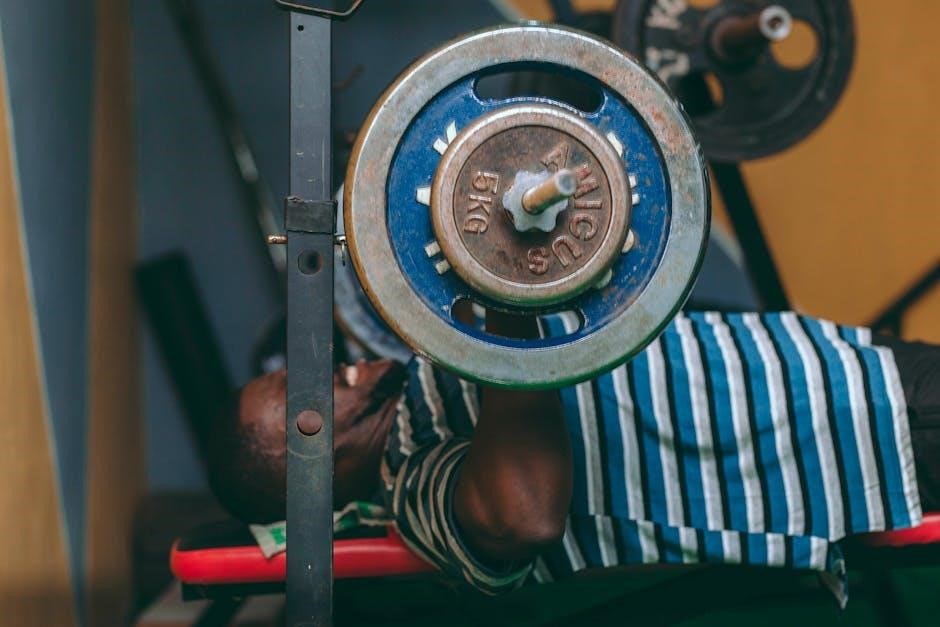Diaper discipline is a structured approach to managing behavior through consistent routines and diaper use․ It combines physical and psychological elements to encourage responsibility and self-control, promoting personal growth and accountability․

Understanding Diaper Discipline
Diaper discipline is a unique approach that blends physical and psychological elements to promote self-awareness, accountability, and personal growth․ It involves the structured use of diapers as a tool for behavior management, often incorporating consistent routines and clear expectations․ This practice is not limited to infants but can extend to individuals of various ages, emphasizing the importance of personal responsibility and adherence to established rules․ Central to diaper discipline is the idea of creating a controlled environment where individuals learn to understand the consequences of their actions through the use of diapers․ This method is designed to foster a deeper understanding of self-regulation and respect for boundaries, while also encouraging open communication between participants and caregivers․ By focusing on both physical and emotional aspects, diaper discipline aims to create a balanced and supportive framework for personal development․

What is Diaper Discipline?
Diaper discipline is a practice focusing on accountability and self-control, combining physical and psychological aspects to foster personal growth and responsibility through structured diaper use․
History and Evolution
Diaper discipline traces its roots to mid-20th-century psychological practices, emerging as a unique approach to behavior modification․ Initially, it was influenced by child development theories and experimental conditioning techniques․ Over time, the practice evolved, blending elements of self-reflection and accountability․ The 1980s saw a rise in its popularity, particularly in alternative communities, as awareness of its potential benefits grew․ Advances in diaper technology and materials further facilitated its adoption, making it more practical and accessible․ By the 21st century, diaper discipline had become a recognized method, with online forums and guides contributing to its widespread acceptance․ Its evolution reflects shifting societal attitudes toward non-traditional discipline and personal growth strategies․ Today, it is valued for its versatility and effectiveness in fostering self-awareness and responsibility․

Key Principles and Objectives
Diaper discipline is rooted in clear principles designed to promote accountability and self-awareness․ The primary objective is to encourage individuals to take responsibility for their actions, fostering a sense of control and maturity․ Key principles include consistency, self-reflection, and the use of diapers as a tool for behavioral awareness․ The practice emphasizes the importance of routine and adherence to established guidelines․ Objectives also extend to emotional growth, helping participants develop resilience and self-regulation skills․ By focusing on personal accountability, diaper discipline aims to create a structured environment that supports long-term behavioral change․ These principles and objectives work together to provide a foundation for effective and meaningful discipline, ensuring that the practice remains both purposeful and transformative․
Types of Diaper Discipline
Diaper discipline encompasses various approaches tailored to different needs and preferences․ The most common types include traditional diaper discipline, which focuses on strict schedules and immediate correction of accidents, and modern diaper discipline, which emphasizes comfort and mental awareness․ A third type is hybrid diaper discipline, blending elements of both traditional and modern methods for a balanced approach․ Each type is designed to address specific behavioral or developmental goals, ensuring adaptability to individual circumstances․ Traditional methods often involve cloth diapers for a more tactile experience, while modern approaches may use disposable diapers for convenience․ Hybrid methods combine these elements, offering flexibility and customization․ Understanding these types allows individuals to choose the most suitable approach for their unique situation, ensuring effectiveness and personal comfort․

Benefits of Diaper Discipline
Diaper discipline fosters improved behavior, enhances self-awareness, and promotes a structured routine, leading to emotional stability and better personal responsibility in individuals․
Behavioral Improvement
Diaper discipline can lead to significant behavioral improvements by teaching individuals to associate actions with consequences․ It encourages self-control, accountability, and adherence to established rules․ Many participants report reduced impulsivity and improved decision-making skills; The structure provided by diaper discipline helps individuals develop better habits and responsibility․ Over time, this can translate into other areas of life, fostering a sense of discipline that benefits overall personal growth․ The clear boundaries and consistent routines often result in fewer behavioral outbursts and a more orderly approach to daily activities․ This method is particularly effective in creating a framework for understanding and respecting limits, which can be invaluable for long-term behavioral development․
Psychological Impact
Diaper discipline can have a profound psychological impact, influencing both emotional well-being and mental health․ For some, it fosters a sense of security and comfort, while for others, it may evoke feelings of vulnerability or embarrassment․ The practice often requires individuals to confront deep-seated emotions related to control, dependence, and self-perception․ This can lead to increased self-awareness and personal growth, as participants learn to navigate their feelings and boundaries․ However, it’s important to approach diaper discipline with care, as it can also trigger anxiety or low self-esteem if not handled sensitively․ Open communication and mutual respect are crucial to ensuring a positive psychological outcome․ The emotional journey associated with diaper discipline can be transformative, helping individuals develop resilience and a deeper understanding of their needs and desires․
Creating a Diaper Discipline Routine

A consistent routine is essential for effective diaper discipline, ensuring structure and predictability․ It involves regular checks, timely changes, and clear communication to maintain comfort and accountability․
Setting Up a Schedule
Establishing a structured schedule is crucial for diaper discipline, promoting consistency and accountability․ Begin by creating a detailed timeline for diaper checks and changes, ensuring regularity․ Set reminders or alarms to maintain adherence, especially during initial phases․ Incorporate both day and night routines, adjusting intervals based on individual needs․ Consistency helps train the mind and body, reducing accidents and fostering responsibility․ Clearly communicate the schedule to the participant, ensuring understanding and cooperation․ Regular checks every 2-3 hours are recommended, with changes performed regardless of soiling to reinforce discipline․ Use verbal cues or visual aids to signal routine activities, helping the individual anticipate and adapt․ Over time, consistency will lead to improved self-awareness and adherence․ Adjust the schedule as needed based on progress and feedback, ensuring it remains effective and realistic․ A well-planned schedule forms the foundation of a successful diaper discipline routine․
Choosing the Right Diapers
Selecting appropriate diapers is essential for effective diaper discipline, as it ensures comfort, reliability, and adherence to the practice․ Consider the balance between comfort and durability, as both are crucial for consistent use․ Cloth diapers offer eco-friendliness and cost-effectiveness over time but require maintenance, while disposable diapers provide convenience at a higher cost․ High absorbency is key to prevent leaks, especially for newcomers․ Adjustable tabs ensure a proper fit, preventing discomfort and leaks․ Style preferences may aid acceptance, though functionality should remain a priority․ Correct sizing is vital to avoid discomfort and ensure effectiveness․ Trying different brands or types can help find the best fit․ Additional features like wetness indicators and odor control enhance training and hygiene․ Psychological factors, such as design preferences, can influence adherence․ Long-term quality and reliability are important, supported by reviews or recommendations; Consider material allergies to prevent reactions․ Cost and budget considerations may lead to exploring combinations of cloth and disposable options or bulk purchasing․ Ultimately, the choice should balance comfort, durability, absorbency, fit, style, features, and cost to support successful diaper discipline․
Hygiene and Maintenance
Maintaining proper hygiene is crucial when practicing diaper discipline to prevent infections and unpleasant odors․ Regular diaper changes are essential, ensuring soiled diapers are replaced promptly․ Dispose of soiled diapers hygienically, using sealed bags to contain odors and bacteria․ For cloth diapers, rinse and wash them thoroughly after use, using mild detergents to avoid skin irritation․ Sanitize diapering areas regularly, wiping surfaces with antibacterial cleaners․ Personal hygiene practices, such as washing hands before and after handling diapers, are vital․ Consider using cleansing wipes for the skin to keep it clean and moisturized․ Proper storage of clean and soiled diapers helps maintain a tidy environment․ Regularly inspect diapers for wear and tear, replacing them as needed․ A well-maintained routine not only promotes health but also supports the effectiveness of diaper discipline․ Consistency in these practices ensures comfort, cleanliness, and long-term success in the discipline process․

Implementing Diaper Discipline Effectively
Consistency, patience, and clear communication are key․ Set realistic goals, ensure understanding, and use positive reinforcement to encourage adherence and foster a cooperative mindset in the process․
Establishing Clear Rules
Clear rules form the foundation of effective diaper discipline․ Begin by defining expectations and ensuring the individual understands them fully․ Consistency is crucial to avoid confusion and build trust․ Involve the person in the rule-setting process to foster a sense of ownership and accountability․ Prioritize rules based on importance, focusing on safety, hygiene, and behavioral goals․ Communicate the consequences of non-compliance clearly, using positive language to emphasize desired behaviors․ Regularly review and adjust the rules as needed to accommodate changing needs or progress․ Documentation can help track adherence and provide a reference point for discussions․ By creating a structured yet adaptable framework, clear rules help guide the individual toward successful outcomes in diaper discipline․

Positive Reinforcement Techniques
Positive reinforcement is a powerful tool in diaper discipline, encouraging desired behaviors and fostering a supportive environment․ Begin by acknowledging and praising progress, no matter how small, to build confidence and motivation․ Reward systems, such as stickers or small treats, can incentivize adherence to the routine․ Consistency in applying these rewards helps reinforce the connection between behavior and positive outcomes․ Use verbal affirmation to highlight successes, creating a sense of accomplishment․ Visual aids, like charts or calendars, can track progress and serve as reminders of goals․ Incorporate fun activities into the routine to make the process enjoyable․ Over time, gradually shift responsibility to the individual, encouraging independence while maintaining support․ Celebrate milestones to reinforce the value of their efforts and strengthen commitment to the discipline․ By focusing on encouragement and rewards, positive reinforcement promotes long-term success in diaper discipline․
Addressing Challenges

Addressing challenges in diaper discipline requires patience, understanding, and adaptability․ Open communication helps identify root causes, while consistent support ensures emotional well-being and practical solutions․

Common Issues and Solutions
Common challenges in diaper discipline include resistance from the individual, inconsistent progress, and emotional discomfort․ Addressing these issues requires empathy and adaptability․ For resistance, open communication and gradual introduction of the practice can help ease concerns․ Inconsistent progress should be met with patience, celebrating small achievements to build confidence․ Emotional discomfort, such as feelings of embarrassment, can be mitigated by fostering a supportive environment and emphasizing the positive aspects of the practice․ Physical discomfort, like skin irritation, can be resolved by ensuring proper hygiene and using high-quality diapers․ Non-compliance may require revisiting the agreed-upon rules and reinforcing their importance gently․ By addressing these challenges thoughtfully, individuals can navigate difficulties effectively and maintain a positive approach to diaper discipline․
Real-Life Examples and Case Studies
One individual, struggling with incontinence, adopted diaper discipline to regain confidence․ Initially hesitant, they found comfort and security in consistent diaper use, leading to improved mental well-being․ Another case involved a caregiver using diaper discipline for a loved one with dementia, resulting in reduced accidents and a more structured daily routine․ A young adult with nocturnal enuresis reported improved sleep quality after incorporating diaper discipline, eliminating the fear of bedwetting․ These examples highlight how diaper discipline can be tailored to various needs, offering practical solutions and emotional relief․ By sharing these experiences, individuals can better understand how to apply the practice effectively and confidently․
Diaper discipline offers a structured approach to managing incontinence, blending care with responsibility․ It fosters confidence, Routine, and self-awareness, providing a supportive solution for diverse needs․


